






By Al Brown Assignment Editor
n Minnesota’s history, there lies a recurring and tragic thread of neglect: the missing voices and faces of Black and Indigenous women.
Joanne Rulford, a 24-year-old African American mother, embodies this enduring mystery and heartache. Her story is emblematic of larger systemic issues that plague minority communities in the state and across the nation.
It was Nov. 1, 1988, a day that started like any other after the annual Halloween festivities. Rulford, a resident of her North Minneapolis community, hosted a Halloween party the night before.
The following morning, she sent her children off to school
from her DuPont Ave. home.
But when her children returned, they found their mother gone without a trace. Hours turned into days, months, and then decades, with no sign of Rulford. Her case has become one of Minneapolis’ oldest cold cases, a haunting reminder that justice remains elusive for many families.
The investigation eventually reached a dead end, with the Minneapolis Police Department (MPD) and the Bureau of Criminal Apprehension (BCA) seemingly at a standstill. Calls to the BCA about Rulford’s case were redirected to the MPD, which has yet to return a call.
The lack of communication raises pressing questions: When did the leads on Joanne Rulford’s disappearance go cold, and why did the MPD halt their search efforts?
By Vickie Evans-Nash Contributing Writer
lack Storyteller Alliance (BSA) was founded in 1971 by Vusumuzi Zulu and his late wife, Nothando Zulu. They are an affiliate of the National Association of Black Storytellers, which presents an annual festival for storytellers. This is the 34th year BSA has held a festival in the Twin Cities.
“It was our attempt to be able to share the art of storytelling from an African and African American perspective with folks in the Twin Cities metro area,” Zulu explains.
Nothando Zulu majored in theater in college. As a member of the local arts community, she gravitated to storytelling. She was friends with Minnesota’s first Black storyteller, Mattie Clark.
Clark, Nothando Zulu, and other local Black theater community members formed the Black Theater Alliance, where they performed impromptu theater in Minneapolis parks.
Nothando Zulu had been go-
ing to national storytelling events every year until she finally convinced her husband to attend in 1995.
“I was in awe and amazed by the power and the beauty of stories that were being told by the master storytellers,” says Zulu. “I said, ‘We just have to do this in Minnesota because most Minnesotans have never been a part of anything like this.”
As a result, the Black Theater Alliance became BSA. They held their first event the following year in 1996; Black master storytellers nationwide were invited to share their talents.
“We made it free, which meant that we used our money,” explains Zulu. “Later on, we were able to secure some grants to help to pay for it.”
For the past 33 years, they have held festivals. “We tell Black folklore, myths, fables, and those [stories derived from] lived experiences,” explains Zulu. “Sometimes folks think that storytelling is just for kids. Well, no. It’s not.” Zulu says audience mem-

bers will find the interactive element most entertaining.
Audience members may be asked to participate: “Come on up, I need Brother Rabbit,” the storyteller may ask.
“It’s more of the African style,” says Zulu. “People are

invited into the story while the story is being told. If you are familiar with going to many Black churches, you’ll know there is call and response. We tell a full range of stories.”
This 34th annual event’s
■ See BSA on page 5
By Aziah Siid
One individual who has been at the forefront of addressing these critical lapses is former State Rep. Ruth Richardson. In 2019, Richardson introduced legislation aimed at establishing a dedicated agency for missing Black women and girls.
After years of advocacy, the law was finally enacted in 2023. However, as Richardson points out, the implementation has been painstakingly slow. “The creation of this agency was a monumental step, yet we’re met with the reality that it still has only one staff member,” she notes. “The new director faces the daunting task of building a functioning team.”
Richardson identifies numerous factors contributing to the disparities in how these cases are handled. She attributes the prolonged periods
during which Black and Indigenous women remain missing to systemic issues within both media and law enforcement agencies.
“There is a chilling apathy from these institutions, often rooted in racism or harmful stereotypes,” Richardson asserts. This indifference perpetuates a cycle where media coverage is scant, and investigative efforts are lackluster when the victims are women of color.
The implications of this apathy are profound. It not only exacerbates the trauma experienced by the families but also emboldens potential offenders.
Richardson cites instances where perpetrators have confessed to targeting Black women, convinced that their
By Delane Cleveland
ver a hundred people work at the Brook-
lyn Park Cub along West Broadway and Brooklyn Boulevard. Come Nov. 16, all those employees will have to find work elsewhere.
However, the union representing those workers is trying to help make that transition as seamless as possible.
“It could happen anywhere.
Unfortunately, it happened to us,” said Muhammed Shayan, a Cub employee.
Shayan works as an e-commerce associate at the Brook-
lyn Park Cub, fulfilling online orders and bringing groceries to people’s vehicles.
He says officials from UFCW Local 663 have been in constant contact with him and his coworkers about options and next steps since learning of the store’s impending closure on Sept. 16.
While Shayan has only worked at Cub a short time, he says some of his colleagues have been here for decades, and this week’s news came as a surprise.
“They were pretty sad because I was here for seven
Cub employee speaks out about Brooklyn Park store’s impending closure ■ See CUB on page 5
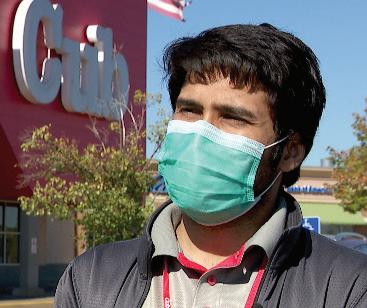
shopping has become more of a financial burden on teachers and families. Inflation and retail supply-chain problems— coupled with school districts that stopped providing what teachers say are classroom necessities—have driven the average price tag to a total that’s closer to a mortgage payment than a yearly expense. With the list of necessities expanding every year, some families and teachers have turned to crowdfunding on
By Izzy Canizares






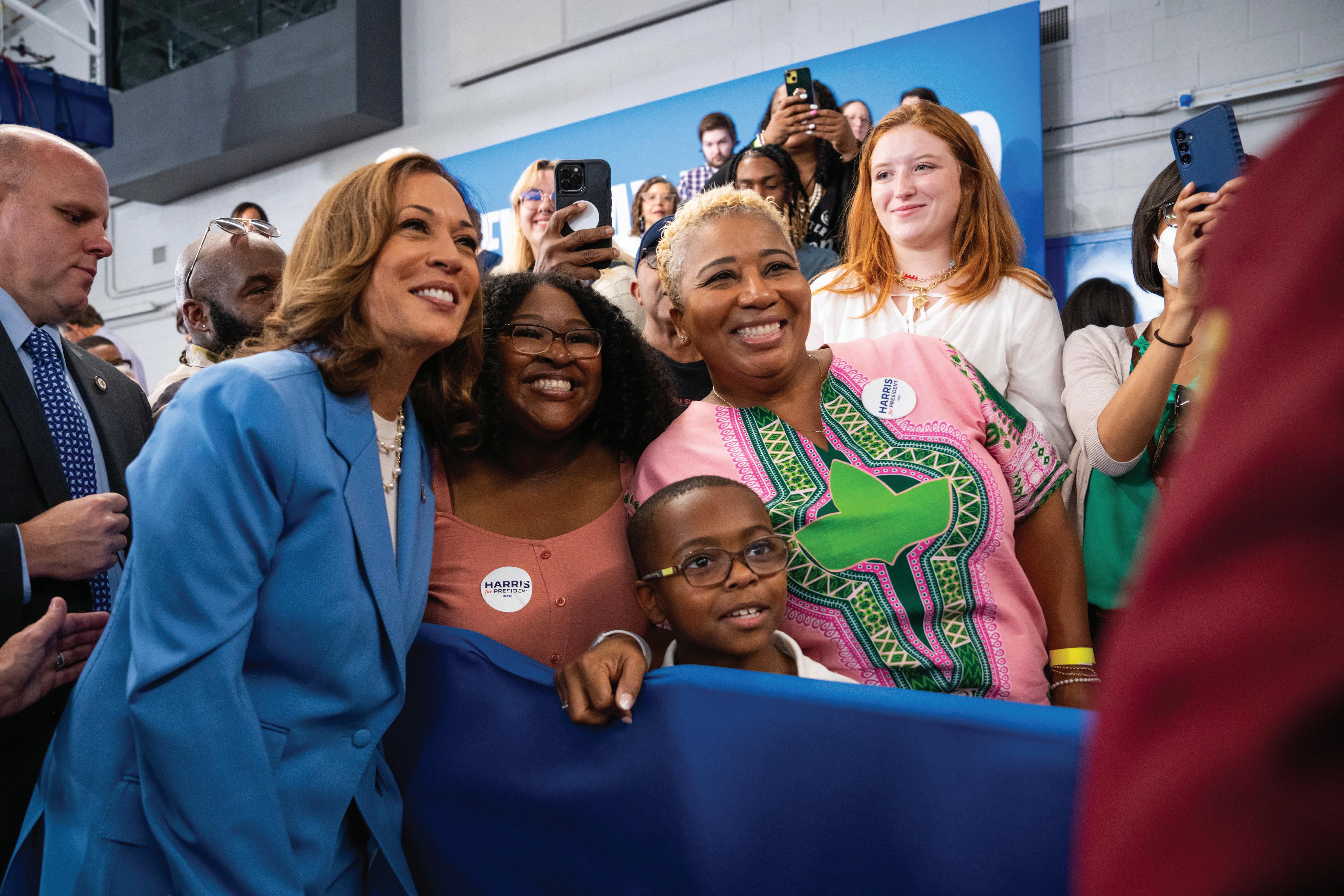
Sponsored by
By Colin Davidson

The U.S. and Canada are in the middle of an opioid epidemic. But opioid use is a growing problem in other countries, too.
Opioid-related deaths make up the largest proportion of drug-related fatalities across the UK, with an average of 40 a week. From patients who have become dependent on prescription painkillers to people addicted to newer, more potent synthetic opioids called nitazenes, new treatments for opioid abuse are desperately needed.
Recent reports heralded the next stage of a 2022 U.S. study. The study found a vaccine for fentanyl addiction showed promising results in rats. According to the reports, the study will soon go to human clinical trials.
If effective in humans, the vaccine might prevent fentanyl abusers from feeling any of the euphoric effects of the drug. It could prove to be an important weapon in the war against opioid addiction. But it’s unlikely to be a silver bullet.
The vaccine works by getting our bodies to produce antibodies that are specific to the fentanyl molecule. These antibodies attach themselves

to part of the fentanyl molecule, stopping the drug from crossing the blood-brain barrier. This means the fentanyl can’t activate the mu-opioid receptors, which are critical for producing the euphoric effects of opioids.
In the 2022 study, male and female rats were given three vaccine doses in weeks one, three and six. The vaccine was found to have several effects. First, it increased the level of fentanyl antibodies in blood serum by the fourth week—and remained relatively stable until the final blood test in week 10.
Next, the rats faced the “tail flick” and “hot plate” tests to check for their perception of pain. Both tests measure how long it takes for the rat to move in response to heat. Typically, fentanyl and other painkillers will increase the time it takes for the rat to move—showing less sensitiv-
ity to pain. However, the vaccinated rats moved quickly in response to heat, showing that the painkilling effect of fentanyl was lost.
The study also found that the vaccine significantly reduced or completely inhibited fentanyl’s effects on blood oxygen saturation, heart rate, and general activity (movement).
Finally, at week 20 of the experiment, rats were injected with a high dose of fentanyl, then anesthetized and killed humanely. Their brains were then examined. Brain levels of fentanyl were very low in the vaccinated rats. The blood serum taken at this point was also tested against other opioids to determine how specific the vaccine was for fentanyl.
While serum from vaccinated rats showed that the antifentanyl antibodies bound to fentanyl, these antibodies did not bind to morphine, metha-

done, buprenorphine, or oxycodone antigens.
This final finding—that the anti-fentanyl antibody was specific for fentanyl and not the other opioids—is important. These other drugs can be clinically useful. Morphine, oxycodone, and buprenorphine are effective painkillers, while methadone is used in treating opioid dependence.
Not there yet
The fentanyl vaccine study is not the first time researchers have tried to develop vaccines for drug dependency. Vaccines for cocaine, methamphetamine, nicotine, and others have all been tested in rats and, in some cases, people.
A 2022 review article found that, of the 23 registered clinical trials examining vaccination for drug abuse, 15 were on nicotine, six were on cocaine, and one each examined methamphetamine and opi-
oids. So far, the clinical data do not support the use of a vaccine for drug dependency.
For example, a cocaine vaccine, despite producing high levels of anti-cocaine antibodies and being relatively safe to use, did not significantly reduce cocaine taking in a group of 130 people. Previous clinical studies have been more effective in drug addicts with high cocaine antibody levels. This may be due to those studies including psychotherapy and methadone in the treatment regimen along with the cocaine vaccine.
Not a perfect solution
Vaccines could be helpful in the treatment of drug addiction—but there are significant barriers to overcome. For example, will those dependent on drugs be motivated to try a vaccine that blocks their high?
Some users might be able to overcome the antibodies in the vaccine by taking larger doses of drugs, which could prove lethal.
Users might take a similar drug (a different opioid, say) that isn’t affected by the vaccine. Also, people have variable vaccine responses so that the vaccine may be more effective in some users than others. Treatment would have to include frequent vaccination because of the limited time of antibody production, which may prove expensive and inconvenient for users.
I have reviewed treatments for drug addictions, and fortunately, there are other devel-
opments in drug abuse therapies, an area with relatively few good treatments. For instance, similar to using methadone for heroin abuse, there are several maintenance or substitution treatments available or being developed for other drugs. Although vaccines to treat drug dependence would be welcome, the root cause of addiction is rarely just a love of drugs—or that people started on painkillers and ended up on fentanyl. Those addicted to drugs are more likely to have complex psycho-social issues.
People with deep psychological problems will have the same issues post-vaccine. They could switch to other harmful substances—alcohol, methamphetamine, cocaine, for example—if the root of their addiction isn’t addressed. As such, any vaccine would only be one aspect of the holistic treatment of addiction, including psychotherapy.
Colin Davidson is a professor of neuropharmacology at the University of Central Lancashire. This story is republished with permission from The Conversation. You don’t have to struggle with addiction and mental health challenges alone. Help is here! For treatment and other supportive resources in Hennepin County, contact the Addiction and Recovery Services Unit at 612-879-3671 or visit the Minnesota Department of Human Services at bit.ly/HennepinGetHelp.

MAKE PLANS FOR THE NEXT SISTER SPOKESMAN: “Caring of our Crowns” November 2, 2024 with an expert hair care panel discussion, products, fellowship, food and fun... details coming soon!


By Alexzia Shobe Staff Writer
What began as a limited 30-piece collection sold from the trunk of Lakeadra
Aaron’s car has transformed into Focused Clothing, now a prominent Black-owned brand proudly located in the Mall of America (MOA), the largest mall in the United States. In the constantly evolving fashion industry, where innovation and persistence intersect, Aaron’s rise from a passionate entrepreneur to a prominent streetwear designer inspires creatives of all disciplines.
Aaron’s path to success wasn’t easy. She encountered significant challenges, particularly in finding manufacturers, which forced her to adjust her approach and continually explore alternative options.
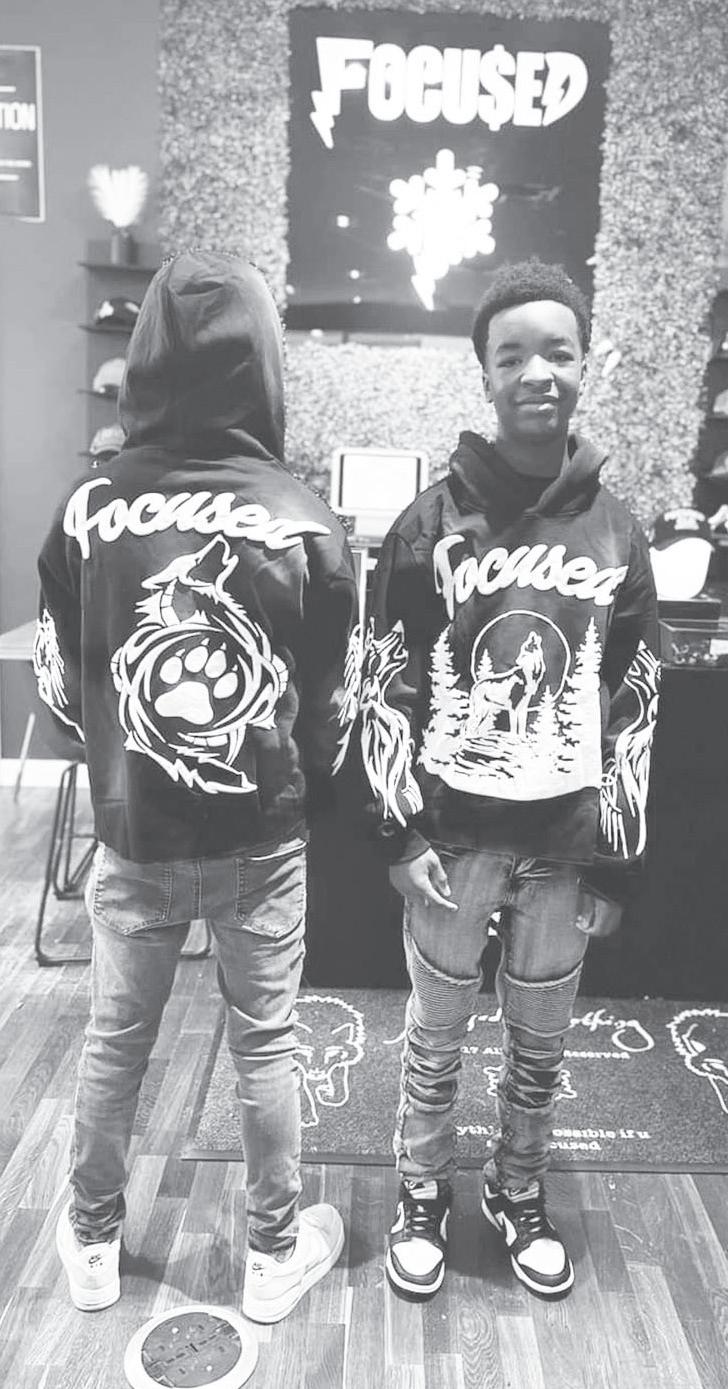
Struggling to find companies to collaborate with, she created and distributed all her merchandise herself. In 2014, she channeled her creativity into painting on t-shirts and jeans, a pursuit she eventually set aside due to its lack of profitability.
It wasn’t until Aaron observed the burgeoning custom brand movement on Instagram in 2017 that she reignited her passion. Inspired by the many fellow designers establishing their online presence and making their brands known, she determined that her goals of being a prestigious presence in the fashion scene were attainable.
“If they can do it, I can do it,” she resolved.
“They’re not just consumers, they are a community.”
Initially, she sold her designs to family and friends, starting with just 30 pieces of inventory. Aaron embraced every opportunity to develop and promote her brand, from ironing and sewing patches onto jackets to securing business cards and participating in vendor gigs. Her dedication and hard work paid off, as word of mouth began driving up interest in her unique designs. With each sale she rein-
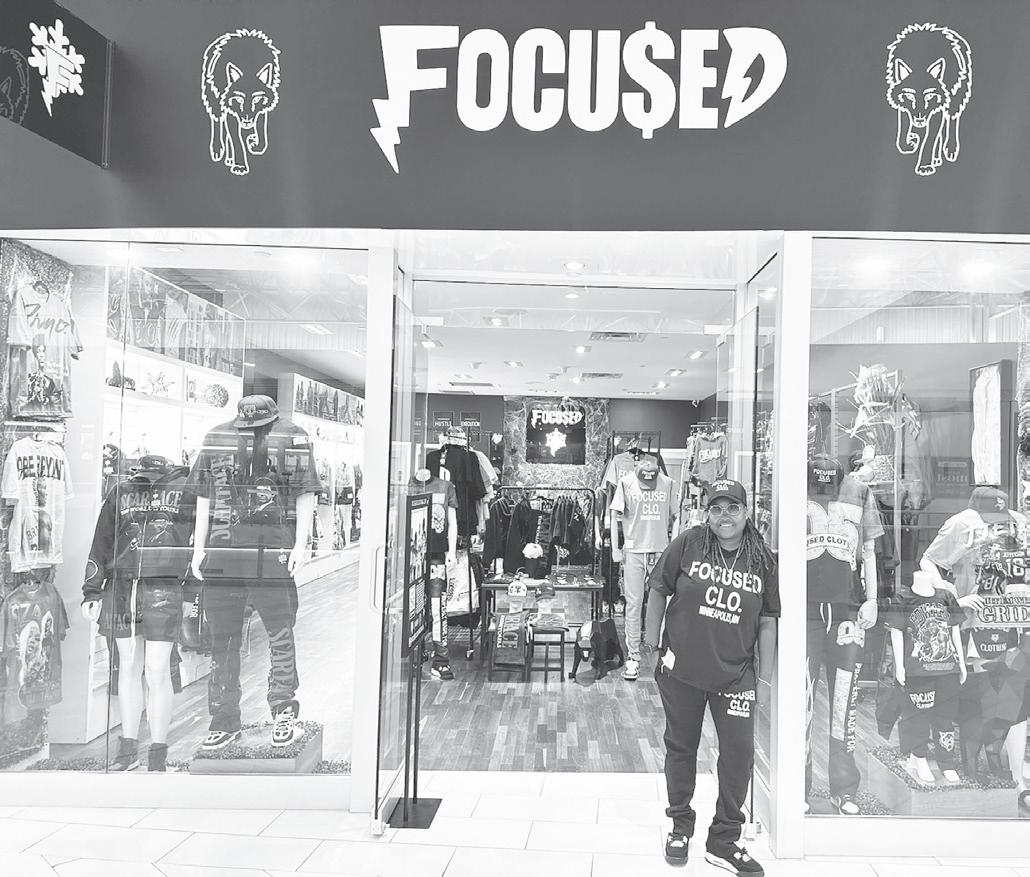
vested in her business, gradually expanding her collection and refining her craft.
Just as her brand was gaining traction, tragedy struck. Hers was among the countless local small businesses devastated by the Covid-19 pandemic and subsequently impacted by the civil unrest in the Twin Cities in 2020. Still, from the depths of adversity, hope rose and revealed the resilience of our communities.
A close friend told Aaron about Community Commons, a market-style retail space at the MOA offering BIPOC business owners three free months of retail space, and she immediately pursued the opportunity.
Still, more challenges emerged. She was placed on a waitlist for a storefront and then offered a kiosk placement at the MOA. Aaron accepted the offer, not realizing that it would render her ineligible for the Community Com-
mons program. She was locked into a two-thousand- dollar- amonth contract. Although she rapidly sold out her inventory due to a flux of interest in her brand, she had to return to working a nine-to-five job to afford the kiosk.
Despite the difficulties she faced, the success of her brand was undeniable. “I knew our brand was really popping off when we saw more and more people proudly wearing our brand, sending us pictures and videos on socials. I realized we were really becoming a staple.
“Our supporters kept coming back for new items, excited for what we would do next,” she enthused. “That’s when I started to feel like we’re a staple here. People know who we are.”
Despite the initial financial strain, Aaron’s fortunes changed dramatically when she secured a storefront at MOA after two years. “God is good. We made over $50,000
in our first month,” she reflected, attributing her success to divine intervention and relentless hard work.
Along with her strong faith, Aaron’s identity as a sapphic Black woman has also played a nuanced role in her business journey. Her unique position has enabled her to build a welcoming community around her brand, where individuals from diverse backgrounds feel comfortable and valued.
Aaron’s approach to business goes beyond transactions, focusing on creating meaningful connections and fostering a supportive environment for customers and peers. “I know many of our customers by first name,” she said, “and we’re friends on social media. They’re not just consumers; they are a community.”
This commitment to com-

munity is mirrored in Aaron’s designs, which vibrantly reflect her personality and experiences. Known for her colorful, youthful, yet serious aesthetic, she strives to craft pieces that captivate attention and make a statement. Her creative process involves keenly observing what is popular at the time and blending that with her innovative twists to create original designs that resonate deeply with her audience.
Balancing current trends with her unique vision, Aaron emphasizes the importance of originality. She uses trends as a template, infusing her designs with personal creativity to ensure they stand out in a crowded market. Her commitment to innovation and quality is evident in every piece she creates.
Looking ahead, Aaron envisions expanding her brand beyond Minnesota. Her plans include opening additional stores in cities like Fargo, Las Vegas, and Chicago to reach new markets and broaden her brand’s impact. Her aspirations reflect a desire to grow locally and nationally while maintaining the authenticity and vision that define her brand.
Lakeadra Aaron’s story stands out as a beacon of perseverance and creative excellence in a world where fleeting fads often drive fashion. Her brand’s success reflects her dedication to craft, community, and pursuing a meaningful legacy in the fashion industry.
Alexzia Shobe welcomes reader responses at ashobe@ spokesman-recorder.com.
By Stacy M. Brown
This year’s Congressional Black Caucus Foundation’s (CBCF) Annual Legislative Conference (ALC) has served as a rallying cry for dismantling the systemic barriers that have long obstructed Black economic advancement. Centered around the theme “From Vision to Victory: Amplifying Black Voices,” the event brought together lawmakers, activists and leaders to confront the policies that have perpetuated the racial wealth gap—a gap that has cost the U.S. over $16 trillion in GDP over the last two decades.
Maryland Governor Wes Moore set the tone with a powerful address outlining the historical injustices that led to this entrenched inequality. “If you don’t understand the Homestead Act, redlining, and how government dollars were
deliberately withheld from Black communities, you won’t understand why this wealth gap exists,” Moore declared. He laid bare the reality that the racial wealth gap was not an accident but the result of policies that actively discriminated against Black Americans. Moore’s message was a history lesson and a call to action. “Racism is expensive. Bigotry is ex-
pensive. This country has lost $16 trillion in GDP because of the racial wealth gap,” he warned.
Moore emphasized the need for bold, comprehensive policies that address the root causes of the gap, from housing to wages to education, urging policymakers to create an economic system where the racial wealth gap becomes history.
The urgency to close the wealth gap permeated the conference’s discussions. Congressional Black Caucus Chair Rep. Steven Horsford (D-NV) highlighted the immense economic power of Black culture and stressed the importance of transitioning from consumers to owners.
“Black people drive the economy because we drive culture,” Horsford asserted. “It’s time for Black America to take ownership of what we help build, to profit from our cultural and economic contributions.”


Rep. Troy Carter (D-LA), cochair of the ALC, spoke forcefully about the need to tear down the systems that continue to limit Black Americans’ access to capital, education and housing. “We must fight for policies that open doors to capital for Black entrepreneurs, invest in workforce development, and eliminate discriminatory practices in lending and hiring,” Carter stated, highlighting how these systemic barriers have long kept Black
communities from achieving economic equality.
Rep. Lucy McBath (D-GA), another ALC co-chair, delivered a poignant reminder of the power within the Black community to overcome these obstacles. “We have the resources, the intellect, and the political power to win this fight,” she said. “But we must act. The power lies in our hands.”
The ALC brought together diverse voices, including NAACP President Derrick
Alexis
Each speaker emphasized that the fight for racial justice is inseparable from the struggle for economic equity, urging attendees to take decisive action. The conference didn’t just highlight the problem; it offered solutions, pushing for policies that would reshape the economic future for Black Americans. Moore’s vibrant reminder of the cost of inaction—$16 trillion lost over two decades—resonated throughout the event. Throughout the week, Moore’s words hung in the air: “Our time in these seats is temporary. We don’t have a minute to waste. We can’t afford to wait any longer.”
Stacy Brown is an NNPA Newswire senior national correspondent.
Continued from page 1
crimes would attract little attention and minimal investigative effort. This grim reality underlines the urgent need for change in how cases of missing persons, particularly those involving women of color, are approached and prioritized.
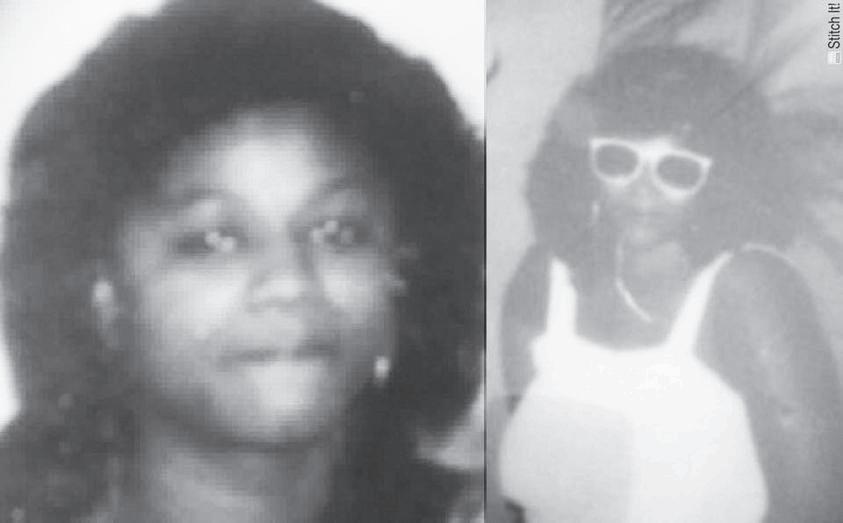
The recent establishment of the Missing Black Women and Girls agency in Minnesota is a glimmer of hope despite its initial staffing challenges. It represents a potential turning point — a shift toward dedicated resources and targeted efforts to tackle the disproportionate disappearances of Black and Indigenous women. However, for the agency to be effective, it requires staffing, funding, and a paradigm shift within law enforcement and media narratives. Moving forward, awareness and pressure from community members and advocates remain crucial. It’s vital for the public to recognize that these cases are not just about statistics or headlines; they’re about
Continued from page 1
theme is “The Legacy of Black Loved Continues,” in honor of the late Nothando Zulu. “Nothando’s name means mother of love,” her husband explains.
“And while she is now an ancestor, we think she is still with us, and the love that she had for the Black community is still present and [should] be shared.”
Outside of the annual festival, BSA provides instruction in the art of oral storytelling from an African and African American perspective through classes. As a 401c3 nonprofit, they travel across the county to schools and businesses
where their local members share their craft. This included four weeks of storytelling at the Minnesota Arboretum this past summer.
On the fourth Monday of each month at UROC in Minneapolis, BSA holds a program called the Black Queens Project for Black women ages 40 and older. Their goal is to use storytelling to combat cardiovascular disease.
“Our mission is to use a safe, trusted space for using storytelling to deal with diabetes and cardiovascular illnesses,” explains Zulu. “We use storytelling to enable Black women, whose number-one cause of death is cardiovascular [disease], and diabetes contributes to that.”
The 34th Annual Black
Storytellers Alliance Festival will feature Dr. Gcina Mhlopde from South Africa, Paul Best from Philadelphia, Toni Simons from Dallas, TX, and
human lives and the grieving families left behind.
By amplifying these voices, we can challenge the status quo, urging both local authorities and the media to treat every case with the
urgency and seriousness it warrants, regardless of the victim’s race or background.
As we remember Joanne Rulford and countless others who remain missing, there is a shared responsibility
As we remember Joanne Rulford and countless others who remain missing, there is a shared responsibility to ensure they are not forgotten.
The event opens on Thursday, Sept. 26, at Perpich Center for the Arts. “Friday, we have the liar contest where folks can come and tell their best
“People are invited into the story while the story is being told. If you are familiar with going to many Black churches, you’ll know there is call and response. We tell a full range of stories.”
Mama Koku from Atlanta, GA. This year’s MC is Gran’ Daddy Junebug from Southern Pines, North Carolina.
tall tale,” says Zulu. “We say that we will offer $250,000 [as a grand prize], but that would be a lie.”
Continued from page 1
months, but some people were here for 27 years,” said Shayan. “So, 27 years is a long time, and they should deserve a new job, and I hope the union will give them a chance.”
On Sept. 29, the Minnesota

Department of Employment and Economic Development will hold several meetings at the Brooklyn Park Cub to inform the staff members of services available through the state’s Dislocated Worker and Unemployment Insurance Programs.
This story was republished with permission from CCX Media.
Obituary
Renée Hunter
“It could happen anywhere. Unfortunately, it happened to us.”
Sunrise: November 24, 1949 — Sunset: September 8, 2024
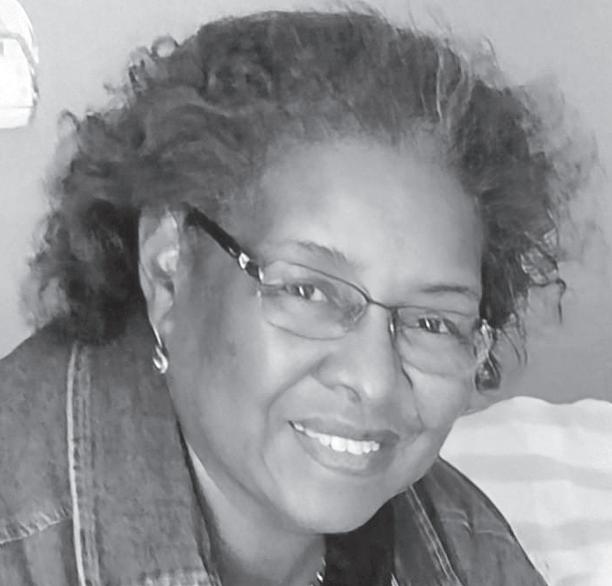
Renée Hunter passed away peacefully at home on September 8, 2024, in Golden Valley, Minnesota.
Renée (Allen) Hunter was born on Thanksgiving Day, November 24, 1949, to Morris and Eddie Mae (Richards) Allen. Growing up in North Mpls., she graduated from North High and went on to earn her master’s degree from St. Thomas University.
She married her childhood sweetheart, Ronald Hunter, in 1974, and they have one daughter, Lindsey. Renée frequently expressed, “I could not have asked for a more loving and caring family; how fortunate I have been.”
Renée loved teaching and did so for 20+ years. She often emphasized, “I feel that early childhood education is perhaps the first and

most important education for young children besides their parents.”
Renée was also a brilliant self-taught gardener, art and antique collector, fashion designer, and interior decorator. She was an empathetic, nurturing woman who always remembered, recognized, and celebrated the birthdays of family and close friends.
Before passing, Renée wrote, “A very special thank you to the women who helped shape me: Sylvia Amos, Adrienne Breland, Yolanda Clark, Alika Galloway, Helen Howell, Bonnie Hunter, Diane Hunter, Arlis Ross, Hazel Sloan, Clara Solomon, and especially my mother.”
Renée was preceded in death by her parents and brother, Richard, and is survived by her loving husband, Ron; exceptional daughter Lindsey (T.Ro); resilient brother, Randy; nephew Rafael (Kimberly); nieces Grace and Aria; grand nephews and nieces Naomi, Caleb, Nina, Nigel, and Jude; grandkids Raeven and Sheila; extra grandkids Emmett, Rose, and Alma; many relatives from Cartersville, GA, along with a host of other relatives and dear friends.
In lieu of flowers, memorials may be directed to Community Covenant Church, Hospitality House Youth Development, or Twin Cities Public Television.
Memorial Service information can be found at www.neptunesociety.com.
SCHOOL Continued from page 1
sites like GoFundMe and Donors Choose to buy construction paper, disinfectant wipes, notebooks, and pencils.
According to the National Retail Federation, families with children in elementary up to high school are expected to spend an average of $875 this year on clothing, shoes, school supplies, and electronics. The average is lower than last year’s record of $890, but it is nearly a $200 increase per family since 2019.
Why does back-to-school shopping cost so much?
Experts say the price of school supplies began rising in the wake of the COVID-19 pandemic, which disrupted supply chains. While retailers have largely recovered, inflation has helped keep prices high, making the school supply shopping trip problematic for low-income Black and Brown households.
At the same time, schools require more technology in the classroom, including computers. Since districts introduced remote learning to K-12 students, the technological disadvantages that some students face have become clear, and schools now require students to have some sort of tablet or computer at home.
A lack of resources impacts everyone
Becky Pringle, president of the National Education Association, is also a grandmother to public school students. Both roles have given her a unique perspective on the rising cost of back-to-school shopping—
to ensure that they are not forgotten—that efforts to find them and the pursuit of justice do not fade into obscurity.
Through ongoing advocacy, reform, and committed action, there is hope that Minnesota can serve as a model for other states in addressing this pervasive issue, bringing about a future where every missing person is given the attention they deserve.
Be sure to read Part II next week: Step by Step: What happens the moment a person is reported missing?
Al Brown welcomes reader responses to abrown@spokesmanrecorder.com.
Anyone—young or old, child or adult—is encouraged to tell a tall tale and win a trophy. “When folks start talking about telling their tall tale, they have to be clean,” warns Zulu. “You can’t do Def Comedy Jam type.” The event includes a free soul food dinner and takes place at North Minneapolis’ Capri Theater.
The grand finale is held Saturday, Sept. 28, at Studio 900, 900 Hennepin Ave., in downtown Minneapolis. The Thursday and Saturday night events offer American sign language for the hearing impaired. Parking is free except for the Saturday event, and all events are held from 6:30 to 9 p.m.
“Folks who have not ever attended will find that they can’t wait until the next time to come back,” says Zulu. “It is
and the effect it can have on students and families who can’t afford to pay for it.
“The impact is not only on the child; it’s on the classroom, it’s on the school, it’s on the parents, and it’s on the community,” Pringle says. She notes that while parents at more affluent schools typically don’t struggle to buy extra classroom supplies, low-income families whose children attend poor or underfunded schools struggle to fill the gap between what teachers need and what their
a different experience when you are involved in interactive storytelling.”
It is a family-friendly event.
“We want our young folks to know and value our stories, our histories,” says Zulu. “To understand the strength, the resilience, the courage that Black folks have shown as we have strived in this country.
“So, when you come to a Black storytellers festival, you will learn about us but you will leave feeling good about it. That’s our goal.”
For more information about BSA, go to blackstorytellers.com or email info@blackstorytellers.com.
Vickie Evans-Nash welcomes reader responses to vnash@ spokesman-recorder.com.
much on Simon’s mind: she purchased extra things for teachers at her daughter’s school, a specialized program for children with developmental difficulties.
“Fruits, a little cookie or chips, food, and some juice,” she says. “No lie: it adds up. I already have to go back to BJ’s to shop to get her snacks in bulk,” Simon says. “When you write this I will send it to her teachers because they really do need money. This is so sad.”
“Imagine what that feels like as a parent to not be able to provide those things that they know their child needs in that classroom.”
districts provide.
“As you unpack it, there are so many inequities and disparities that are built in reality with back to school,” she says. “While [teachers] say (classroom supplies) are not mandatory, I just want you to imagine what that feels like as a parent to not be able to provide those things that they know their child needs in that classroom.”
To avoid that tension, states like California have banned schools from sending home school supply lists for classrooms. But in other places like New York City, teachers now more than ever depend on parents to fill the holes.
That seemed to be very
Ways to get around the hefty cost
Look around your neighborhood for local organizations or individuals hosting backto-school events for families. Free or low-cost school supply drives, haircuts, and other community resources like dental and medical care are usually available if you look in the right places.
Social media and the internet are also good resources for free supplies. Banks or other institutions also host back-toschool events.
By Stacy M. Brown
Stevie Wonder has announced that he’s bringing a “joy over anger” message this fall with his “Sing Your Song!
As We Fix Our Nation’s Broken Heart” tour.
The 10-show run begins on October 8 in Pittsburgh and concludes on October 30 in Grand Rapids, Michigan. This tour arrives at a crucial junction in American politics, and Wonder said he’s seeking to inspire unity and healing.
Tickets for the tour went on sale Friday, September 20. The legendary singer will make a stop in Minneapolis on October 27.
Wonder, a 25-time Grammy Award winner, will offer free tickets to individuals working tirelessly in their communities to mend “our nation’s broken heart.” The gesture aligns with Wonder’s long-standing commitment to social justice and humanitarian causes.
In his recent release, “Can We Fix Our Nation’s Broken Heart,” Wonder sings about the country’s current challenges.
The song reflects the nation’s mood with lyrics like, “Children marching on the boulevard / Tears are streaming down their face,” encapsulating the tension and hope for change.
The Wonder Productions-
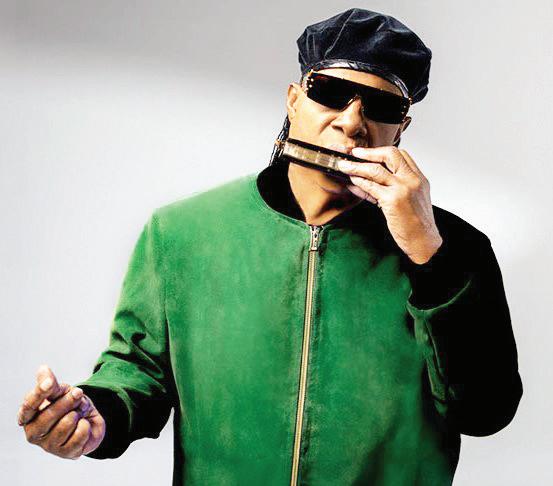
Stevie Wonder
led tour, which AEG Presents promotes in collaboration with Free Lunch, will visit cities such as New York, Philadelphia, Baltimore, Greensboro, Atlanta, Detroit, Milwaukee and Minneapolis. Wonder’s impact on music and culture remains unquestionably profound. At just 12 years old he became the youngest artist to top the
charts with “Fingertips, Part 2,” simultaneously reaching #1 on Billboard’s Hot 100, R&B Singles, and Album charts.
Over his illustrious career, Wonder has released numerous iconic albums, including “Songs in the Key of Life,” which is preserved in the National Recording Registry of the Library of Congress for its cultural, historical and aesthetic

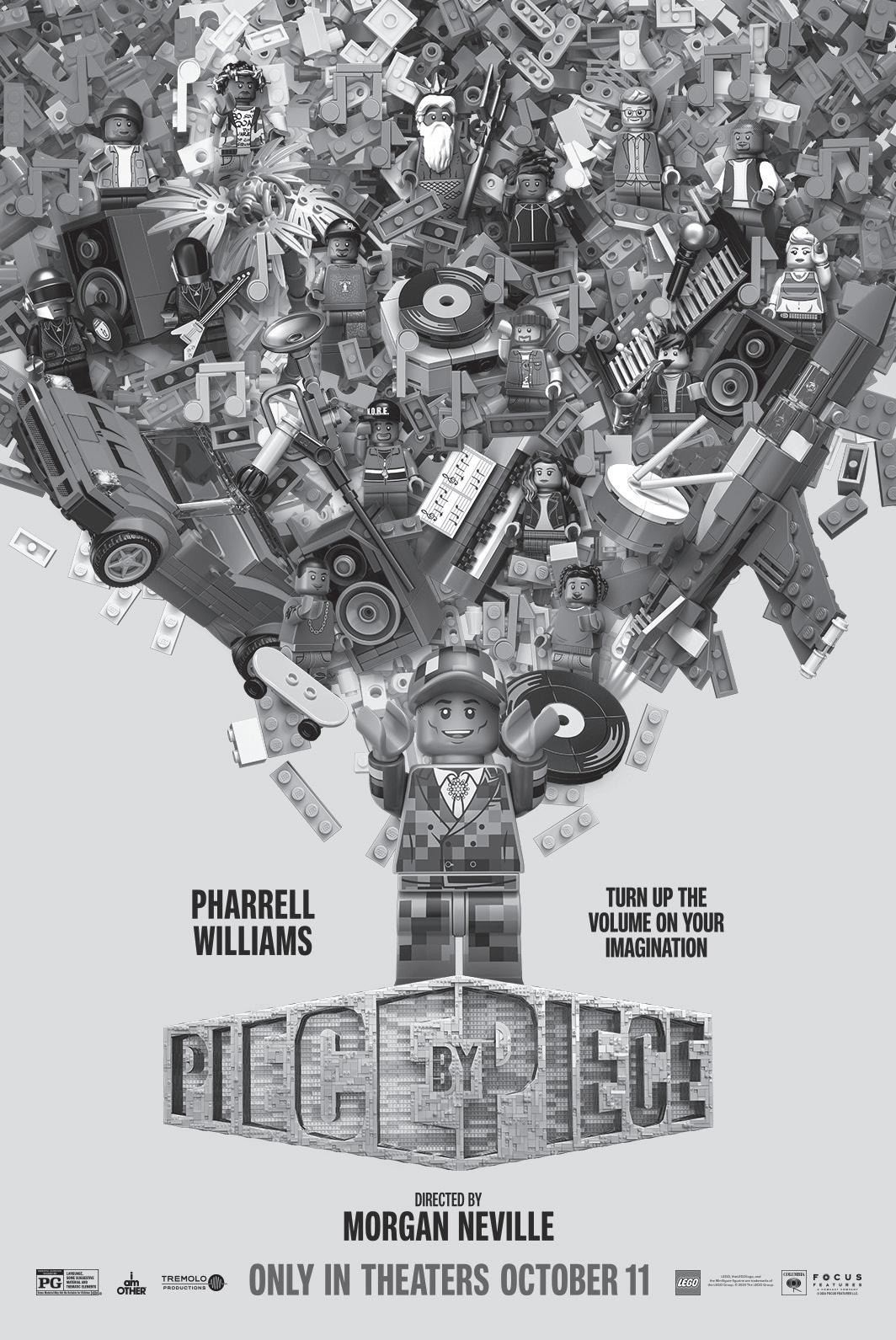

significance. With 49 Top Forty singles and 32 #1 hits, Wonder’s worldwide sales have surpassed 100 million units. Beyond his musical achieve-
ments, Wonder is known for his activism and philanthropy.
In 1983, he played a pivotal role in establishing Martin Luther King Day as a national holiday, with his song “Happy Birthday” serving as an anthem for the movement.
disabilities.
As Wonder embarks on this tour, he continues to be a vital influence in the music industry and global activism, using his platform to advocate for social progress and world harmony.
With his call for “joy over




His participation in the 1985 “We Are The World” fundraiser for hunger in Africa is a landmark moment in music history, and his efforts to end apartheid in South Africa are legendary.
Wonder has been recognized with numerous honors, including the Presidential Medal of Freedom, the Kennedy Center Honors, and a U.N. Messenger of Peace designation focusing on persons with



anger,” Wonder said he’s inviting audiences to join him in “seeking healing and unity during these challenging times.”
Tickets for Stevie Wonder’s Oct. 27 show at the Target Center can be purchased at StevieWonderLive.com.
Stacy M. Brown is the NNPA Newswire senior national correspondent.


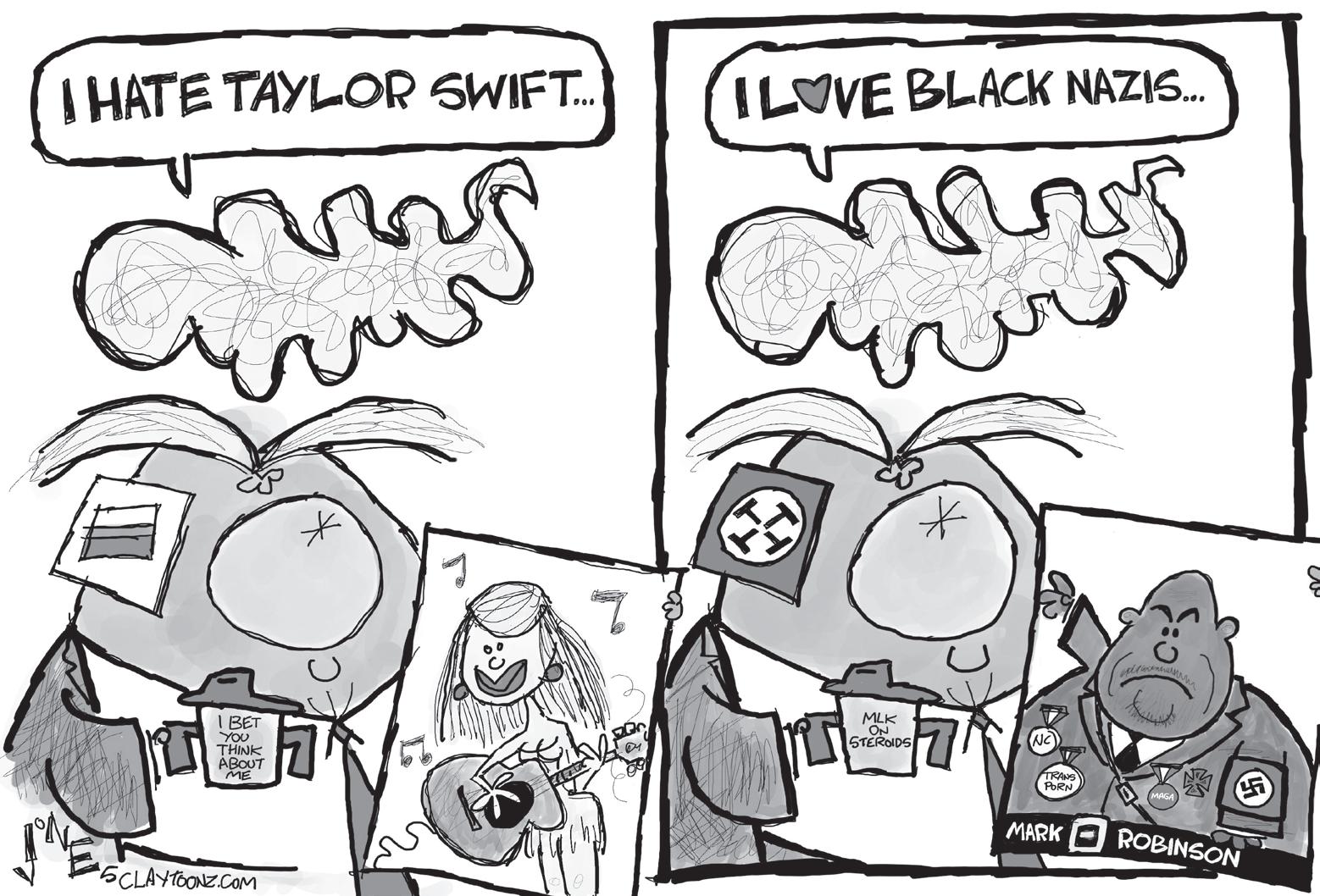
By Yvette Clarqke
As we approach this upcoming election, we must examine the threat that artificial intelligence (AI) will bring to our ability to participate in a free and fair election and the ramifications of another four years under Trump with the implementation of Project 2025.
For years, I’ve stood at the forefront of Congress’s fight to regulate AI and the many technologies born from advancements in this space. I have been raising concerns with my colleagues in Congress and emphasizing that without appropriate safeguards in place for AI, we risk facing dire consequences, such as the rapid spread of misinformation and disinformation.
When Elon Musk shared a deep fake video of the vice president, I knew this problem was a long time coming. Earlier in the year, President Biden’s voice was cloned using AI to send a fake robocall to thousands of voters in New Hampshire.
This is particularly significant for communities of color nationwide, including families in New York’s 9th District in Brooklyn. A recent report showed at least 40 million Americans might be regularly targeted and fed disinformation in Black online spaces by a host of sources throughout social media, fueling false information around the election.
The past few election cycles have seen misinformation weaponized and targeted at communities of color by racist and antidemocratic actors who seek to intimidate voters of color and use lies to discourage
Black people from participating in the democratic process.
Unfortunately, far more than our ability to responsibly regulate AI is at risk this November. The truth is far more terrifying.
The truth is that our freedoms are at stake. If elected, Trump and his gang will enact Project 2025—a 900-page manifesto published by the Heritage Foundation, as a guide to implement their far-right, radical policies nationwide and uproot the very foundation upon which our American values and principles are built.
of the Black population in Virginia, particularly in the Tidewater area around the Chesapeake Bay.
In the centuries that followed, people from the nations of Haiti, Jamaica, the Bahamas, the Dominican Republic, and more arrived in this nation, becoming doctors, caretakers, Oscar-winning actors like Sidney Poitier, activist-musicians like Harry Belafonte, and even legendary politicians like my idol, Shirley Chisholm.
Project 2025 would treat immigration as a threat to the nation rather than the great benefit it has always proven to be.
As a daughter of Jamaican immigrants, part of my lived experience was learning to understand and appreciate my parents’ journey to their American dream. Brooklyn, including the 9th District, is a portal that is representative of the world’s cultures and peoples, and many of my constituents also share those experiences.
As a Caribbean American, I understand their origin stories and how valuable becoming citizens of this great nation is to everyone—particularly those I represent. The Caribbean community has a long history with the United States.
The history of Caribbean people dates back as far as slavery in this country. As time passed, enslaved people brought from Barbados formed a substantial portion

Caribbean culture was molded into this great American mosaic, adding different foods, music, and a stubborn sense of self-determination.
Immigration is the centerpiece of the former president’s campaign to retake the White House, and if he wins a second term in November, he has pledged to embark on the biggest deportation program in U.S. history.
Trump has suggested that he deputize local police officers to identify suspects and make arrests, and he has said that they would be granted “immunity.” In an interview with Time magazine earlier this year, he bragged about the speed at which he would deport tens of millions. A mass deportation plan on this scale is pure horror with no consideration of humanitarian concerns or family separations.
Project 2025 even calls for Immigration and Customs Enforcement (ICE) officers to be allowed to carry out “civil arrest, detention, and removal of immigration violators anywhere in the United States, without warrant where appropriate.”
It’s not difficult to imagine what kind of communities they would target first, especially considering that the former president referred to Haiti and African nations as “sh*thole” countries, legitimizing the targeting of people of the African diaspora and furthering his agenda to restrict immigration policy in a potential second term.
Project 2025 seeks to destroy Temporary Protected Status (TPS), cutting more than 850,000 individuals from the program and repealing all active TPS designations. This is more than troubling at a time when my colleagues and I in the Haiti Caucus have been continuing to beat the drum for expanding the TPS designation for our Haitian brothers and sisters as the island nation of Haiti has descended into chaos from political instabilsubmissions@spokesman-recorder.com submissions@spokesman-recorder.com submissions@spokesman-recorder.com.
By Geri Sanchez Aglipay
In Minnesota, the Great Lakes Region, and nationwide, the small business start-up boom is largely led by owners from traditionally underserved communities—and the Latinos help lead. In the last three years, America has had the fastest creation rate of Latinoowned small businesses in three decades.
From September 15 to October 15 each year, National Hispanic Heritage Month acknowledges the contributions of diverse cultures and their historical impact in America, like the current record-high Latino entrepreneurship. Under landmark bi-partisan legislation passed under the Biden-Harris administration’s Investing in America economic agenda, Hispanic small business owners are catalyzing Minnesota’s economy and strengthening America. They’re gaining contracts, increasing revenues, and creating good-paying jobs from infrastructure projects such as highspeed internet installation, lead pipe abatement, re-shoring manufacturing, and improving climate-resilient roads, bridges, homes and buildings.
Customer growth and revenue expansion bode especially well for small firms certified through SBA’s contracting
assistance programs such as HubZone, women-owned small business, 8(a) Business Development program, or service-disabled veteran-owned working with the SBA and Minnesota DEED.
Job creation by Hispanic small businesses contributes to closing the wealth gap, wherein Hispanic and Latino households only own about 15 to 20% of the net wealth held by the average White household.
Equity has been a priority from day one of the Biden-Harris administration and the SBA. Being in the field, I’m acutely aware that finding business funding and trusted advisors that impart the knowledge and capital needed to manage funding and run a business can be daunting. For too long, systemic obstacles have prevented most Latino entrepreneurs from accessing the money, tools and resources for business success.
The SBA is working hard to deliver affordable capital, accessible contracts, and unbiased counseling to Latino small businesses. Under SBA Administrator Isabel Casillas Guzman’s leadership, the U.S. Small Business Administration (SBA) federal agency has made extraordinary progress in knocking down barriers.
Under Administrator Guz-
man’s leadership, the Latino share of the SBA’s lending portfolio has grown four percentage points in the last three years, from 7.8% to 12.2%. In fiscal year 2023, the agency funded a record-shattering $3 billion to Latino-owned small businesses.
In this great North Star State and the five states in the Great Lakes Region, we’ve increased funding by nearly one-third to Latinos over the last three years since fiscal year 2021.
American small business ownership is at a green zeitgeist with the Investing in America economic agenda. It’s critical to advance business success and sustainability while addressing climate change to ensure that businesses, families and communities have clean air, water, and affordable and safe transportation.
All this enriches our business, work, education and recreational activities while lowering business costs, generating energy savings, and advancing financially stronger and healthier communities.
During Hispanic Heritage Month, let’s recognize the success of Hispanic-owned businesses and ensure they receive ongoing support to thrive in America, so we all continue to benefit.
Geri Sanchez Aglipay is the SBA Great Lakes Regional administrator. For more info, visit www.sba.gov.
The urgent need for peace in Sudan
By Chris Houston
Last month, the International Rescue Committee described the crisis in Sudan as the top global humanitarian emergency. On August 28, Lawrence O’Donnell described the war in Sudan as the “least reported humanitarian crisis on the planet.”
Levon Sevunts is a former journalist who works for the UN refugee agency, UNHCR. He had recently returned from Chad, a country hosting 633,867 people who have fled Sudan.
Sevunts spoke to me about his trip: “For me, this was an absolutely surreal experience to be back in Chad almost 20 years to the day after I went to Chad as a Canadian journalist, covering the conflict in Darfur, seeing the same stories, the same refugees, only on a much bigger scale.”
Sevunts said, “The stories I heard from speaking to Sudanese women refugees, who had seen members of their families executed in front of their eyes, of women who told me about worrying about how they’re going to feed their kids, worried every time they went fetching wood beyond the security of the camp that they would get raped or assaulted— worried, but they had to do this anyway because they needed to feed their families.”
Sevunts recalled, “I was with a journalist in this border town called Adré, a town on the Chadian side of the Sudan border, but it’s right on the border. This is the place where most of
ity, natural disasters, and gang violence.
Project 2025 would treat immigration as a threat to the nation rather than the great benefit it has always proven to be.
the refugees come fleeing from violence.
“I was speaking with my colleagues about the kind of cases they were seeing. They were saying there is a big difference now because, in the initial months when the conflict started in mid-April, especially around June when the violence spread in Darfur, they were seeing a lot of people coming in with injuries and gunshot wounds, shrapnel.”
“Food is trucked all the way through the Sahara desert, all the way from Libya, south to Chad, and from Chad, some of it goes to Sudan. And this means that prices have jumped. So not only do humanitarian agencies have to buy items from local markets, but the prices of things at the market have gone up because of the logistical difficulties that the war has created.”
“What you are seeing now is that a lot of people are coming in extremely malnourished. This is basically a man-made food crisis.”
He told me, “What you are seeing now is that a lot of people are coming in extremely malnourished. This is basically a man-made food crisis. Because of the war, farmers are not able to plant in their fields; they have missed one planting season already, their crops were burned, and their livestock was destroyed or taken away from them.
“So you have this incredible humanitarian situation inside Sudan, but it’s also playing out on the Chadian side of the border because before the war, this part of Chad used to get most of its food imports from Sudan, and now it’s vice versa. So now they have to truck food all the way from Libya because the area doesn’t provide enough food for the population.
Now more than ever, we must protect the great American mosaic we have worked so diligently to craft. We came here not to create division, fuel xenophobia, or strengthen extremism but to spread one love, build unity, and have the opportunity to reach our highest aspirations. We must fight on.
Sevunts explained that not just the refugees but also the local population are worried about putting food on the table for their own families. He called on the international community to step in with immediate humanitarian assistance.
But he also noted that “humanitarian aid is just a band-aid solution” and said that “what they really need is peace in Sudan. Because unless there is a lasting ceasefire and peace talks, this conflict threatens not only to destroy Sudan as a functioning state, but it also threatens to destabilize the entire region, a very, very fragile part of East and Central Africa.”
Chris Houston is the Canadian Peace Museum nonprofit organization’s president and columnist for The Bancroft Times.
There is no future for the Caribbean community in Project 2025. It is time for us to use our inalienable rights as Caribbean Americans, do our civic duty, and head to the ballot box—because we are not going back.
Yvette Diane Clarke has


As the Minnesota Spokesman-Recorder approaches its 90th anniversary, you’re invited to commemorate this historic milestone by donating $90 to celebrate 90 years of continuous publication.
As the Minneapolis Spokesman-Recorder begins its 90th Anniversary year, you’re invited to commemorate this historic milestone by donating $90 to celebrate 90 years of continuous publication.
Your generous contribution will support our legacy of dedicated community empowerment through journalism and ensure our vital work continues into the future.
As a “$90—for- 90” contributor (non-business), your name will be prominently displayed in our print and digital editions until the week of Aug. 10, 2025. The paper was founded on Aug. 10, 1934.
As a “$90-for-90” contributor (non-business), your name will be prominently displayed in our print and digital editions until the week of Aug. 10 — the date of our founding in 1934.
Please consider this unique opportunity to stand collectively with the MSR, honoring 90 years of tradition and community service. For inquiries or to join as a “$90-for-90” supporter, call 612-827-4021, visit our website, or email admin@spokesman-recorder.com.
Anita Alexander
Ray Seville Productions
Torrion Amie
Kimerlie Geraci
Holly Andersen
David Fettig
Nancy L. Beals
Tracy Wesley
Jonathan Beck
The O’Neill Family
Clara Boykin & Family
Liam Cavin
Gretchen Bratvold
Amanda Brinkman
Your Name Here
Toweya Brown-Ochs
Your Name Here
Benjamin F. Bryant & Dr. Antusa S. Bryant
Your Name Here
Deanna Callender
Your Name Here
Shirlee L. Callender
Your Name Here
Liam Cavin
Your Name Here
Janis Clay
Your Name Here
Edward Coblentz
Your Name Here
Coventry Cowens
Michael Davis
Your Name Here
Victoria Davis
Your Name Here
Michael Diehl
Your Name Here
April A. Estes
Your Name Here
George Ewing
Your Name Here
Elizabeth Fealey
Your Name Here
David Fettig
Your Name Here
Readus Fletcher
Your Name Here
Ken Foxworth
Your Name Here
Michael Franks
Your Name Here
Your Name Here
Lee Friedman
Ella Gates-Mahmoud
Your Name Here
Kimerlie Geraci
Your Name Here
Erick Goodlow
Your Name Here
Leota Goodney
Your Name Here
Pamela Hall-Clemens
Your Name Here
Hendon Group, Inc
Colnese Hendon
Your Name Here
Connie Hudson
Your Name Here
Angelo Hughes
Your Name Here
Katie Izzo
Your Name Here
Nina Johnson
Your Name Here
Clarence Jones
Your Name Here
Debra Jones
Your Name Here
Shirley R. Jones
Cynthia Kelly & Murry Kelly Jr.
Your Name Here
Your Name Here
Nathaniel Khaliq
Zena Kocher
Your Name Here
Jimmy Lewis
Your Name Here
Lisa Lissimore
Your Name Here
Michele Livingston
Your Name Here
Harlan Luxenberg
Your Name Here
MRPP and Associate Communications
Your Name Here
Melanie Manaen
Your Name Here
Kyle Meerkins
Your Name Here
Deborah Montgomery
Your Name Here
Debbie Morrison
Marcia Murray
Mary K. Murray Boyd
Your Name Here
Dan Ness
Your Name Here
Sanda Noy
Your Name Here
The O’Neill Family
Your Name Here
Minister Dr. Ni Ora Hokes
Your Name Here
Liz Oppenheimer & Jeanne Burns
Your Name Here
Ray Seville Productions
Your Name Here
Mary Quinn McCallum
Your Name Here
Amy Pfankuch
Your Name Here
Patty Ploetz
Mark Ritchie
Your Name Here
Lyn Rabinovitch & John Saxhaug
Your Name Here
Your Name Here
Augustus Ritemon
Carolyn Roberson
Your Name Here
St. Paul Saints
Your Name Here
Floyd Smaller
Your Name Here
Chanda Smith Baker
Your Name Here
South Hill Film
Your Name Here
Ronald Spika
Cyriaque Sukam
Your Name Here
Timothy Sullivan
Your Name Here
Heidi Swank
Your Name Here
Dotty Timmons
Your Name Here
Nicholas Upton
Your Name Here
Jason Walker
Your Name Here
Dr. Betty Webb
Bill Wells
Tracy Wesley
Your Name Here
Jeffery Young
Your Name Here
Your Name Here
Your Name Here
Your Name Here
Your Name Here
Your Name Here
Your Name Here
Your Name Here
Your Name Here
Your Name Here
Your Name Here
Your Name Here
Your Name Here
Your Name Here
Your Name Here
Your Name Here
Your Name Here
Your Name Here
Your Name Here
Your Name Here
Your Name Here
Your Name Here
Your Name Here
Your Name Here
Your Name Here
Your Name Here
Your Name Here
Your Name Here
Your Name Here
Your Name Here
Your Name Here
Your Name Here
Your Name Here
Your Name Here
Your Name Here
Your Name Here
Your Name Here
Your Name Here
Your Name Here
Your Name Here
Your Name Here
Your Name Here
Your Name Here
Your Name Here
Your Name Here
Your Name Here
Your Name Here
Your Name Here
By Dr. Stephanie Boyce
In 2024, the Centers for Disease Control (CDC) reported an estimated 7 million U.S. children aged 3-17 years (11.4%) have been diagnosed with Attention Deficit Hyperactivity Disorder (ADHD), according to a national survey of parents. While the debate on the causes of the rising cases of ADHD may go on forever, school systems and educators are grappling with the reality of these numbers and what it means to effectively teach students in classrooms daily. It doesn’t take much interrogation of the ADHD data for obvious disparities to surface and raise questions. For example, in their study, the CDC reported that boys (15%) were more likely to be diagnosed with the disorder than girls (8%). Furthermore, many of the children grappling with ADHD also experience co-occurring conditions such as anxiety, depression, behavior disorders, autism spectrum disorder (ASD), etc.
For many educators, navigating the needs of many culturally divergent students, in addition to the demands of high-stakes testing and other administrative obligations, may leave them underprepared to meet the needs of the students when problematic behaviors manifest in their classrooms.
One unintended consequence of this overwhelm is evident in the disparities that emerge in how children of color are over-disciplined in classrooms when compared to their white counterparts.
Black and Latina boys
over-disciplined
In a video experiment of over 1,339 teachers in 295 schools, the American Sociological Review found that, compared to white boys, Black and Latino boys experience both (1) individual-level teacher bias,

where they are perceived as being more “blameworthy” and referred more readily for identical misbehavior, and (2) racialized organizational climates of heightened blaming, where students of all races/ethnicities are perceived as being more “blameworthy” for identical misbehavior in schools with large minority populations versus in predominantly white schools. In other words, teachers were more likely to write a discipline referral for students of color when they witnessed them commit the same offense as white students, but they were also more likely to blame students for behavioral issues when they worked in a school that had a large population of students of color.
Claire Sibonney expresses a similar sentiment in her ar-



ticle, ”Underdiagnosed and Undertreated, Young Black Males With ADHD Get Left Behind.”
According to Sibonney, educators disciplining Black kids, specifically, leads to them receiving more criminal prosecution and less of the mental and medical support they may need to manage their behavioral issues effectively.
In a study of 4,297 children and parents surveyed over three waves (fifth, seventh, and 10th grades), the National Center for Biotechnology Information found that African American and Latino children had fewer odds of receiving an ADHD diagnosis, and even when they did, they were less likely to receive medical treatment for the disorder.
For example, among 10thgrade children at the highest
symptom level, 65% of white children were taking ADHD medication, according to a parental report, compared with 36% of African American children and 30% of Latino children.
Parents/guardians must be advocates
peractivity and impulsivity for more than six months).
The therapist can make recommendations to a psychologist and psychiatrist for testing, diagnosis, and treatment for ADHD. This process requires resources and time that many parents may not have avail-
Parents are the first line of defense for helping students of color get the diagnosis and support they need to navigate educational institutions and secure their future success. Many parents are unaware of all the factors at play or the rights and protections policies afford them and their children.
Parents, unlike educators, become the connectors between medical professionals and educational organizations. For instance, when a parent enrolls their child in therapy, a child’s therapist may be able to identify recurring symptoms (typically six or more for inattention and six or more for hy-
able. However, parents are uniquely positioned to see a child’s problematic patterns of behavior before any educator and for longer than the course of a year.
When symptoms of ADHD start to surface, many parents, who may often not be mindful of their own mental health, may default to punitive disciplinary measures that are more culturally accepted than going down a path to diagnosis and treatment with children of color.
Culturally engaging educators
One of the other pieces to this puzzle is the need for educators to commit to creat-







ing culturally relevant classrooms for the students they serve. Decades of research have shown that students of color see more academic success and decreased behavioral referrals when their teachers create learning experiences and environments that are culturally responsive to them. In a time where we are learning so much more about ADHD and its impact on students in schools, parents and educators have many opportunities to partner and ensure that each child receives what he or she may need to navigate and have a successful schooling experience. Fortunately, we are learning more about what is required and where the disparities exist so that more collaboration and partnerships may be created to propel students forward to having all the support they need as they navigate living with their differences and becoming the most productive citizens our communities need them to be.
The post Disparities in ADHD Diagnosis and Collective Solutions appeared first in Dallas Weekly. Dr. Stephanie Boyce contributes to the Dallas Weekly. She currently serves as Stephanie Boyce & Associates, LLC.’s CEO and executive director of its giving arm, The FRESH Classroom, a 501(c)(3.

Minnesota 55101-2134 (651) 757-1039 (Voice) (651) 297-4077 (Fax) andrew.gross@ag.state.mn.us
19, 26 & October 3,2024

Dated:

James P. Conway MN# 0391044
206 Scott Street, Shakopee, MN 55379
Telephone: (952) 445-2817
Facsimile: (952) 445-812
e-mail: jconway@jmwlaw.com
Continued from page 12
[with] more ambitious but more realistic goals for myself,” continued Unongo, the team’s only Black player. “I think I can bring a lot of unique things to this team that no one else can bring.
I’m really excited to just be myself more authentically, and just bring what I can bring to the table.”
It’s often said that the biggest improvement for a player or a team occurs during the off-season. “Summer was super busy,” recalled Unongo, “but it was good. Lots of training, lots of touches in the gym, lots of time with teammates. Little of rest here and there.
“It was a good summer, got me ready for this season,” said Unongo.
St. Thomas has won eight of its last nine matches to close its 2024 non-con-
ference play.
“I think this season we all expect to come out way better than we did last season,” Unongo stressed. “We are really focused on putting our everything into every game that we have.”
Although the visiting Tommies fell 3-0 to Minnesota, Unongo told us the team left that night defeated on the court but not in spirit. “Even though the result didn’t go as we wanted in this game,” she said, “we gave it our all, and that’s all we can ask each other to do.”
With the non-conference season in the books, St. Thomas welcomes North Dakota State to begin league play.
“We’re all connected, staying together, so we’re really excited to play this year,” concluded Unongo.
Charles Hallman welcomes reader comments to challman@ spokesman-recorder.com.

Continued from page 12
in the U.S. during the WNBA off-season as well as providing playing opportunities for other players not on WNBA rosters.
ball landscape, but [also] for the players specifically to create another first class experience,” said Perry.
of at least 3,400 players who played in the seven Negro Leagues that operated between 1920 and 1948.
Gorton bemoaned that the legendary Black pitcher again will be overlooked both by MLB and Cooperstown. “It brings up the opportunity
“You’re
Please Note: New email address for all future ads is ads@spokesman-recorder.com
Basketball legend Sheryl Swoopes, two-time NBA champion Kevin Durant, and soccer superstar Abby Wambach are among many others on the AU Advisory Board.
The MSR handles billing digitally. This means you will get e-tears and e-mailed invoices unless you specifically request a hard copy.
“Our players deserve more opportunities to be able to perfect their craft for as long as they can,” stressed Perry.
A former Division I college basketball player, Perry has over 15 years of experience in sports, media and entertainment, including eight years with the WNBA in basketball operations and player relations (2010-16) and team marketing and business operations specialist (2008-10).
She joined AU in 2023 and works closely with the AU Player Executive Committee to oversee all league operations both on and off the court.
“This will be my second season with Athletes Unlimited,” declared Perry. “I had been around the game for a long time. When this opportunity came across my path, I realized that I have more to give to the game. I want to help grow this game.”
“I have an opportunity with the knowledge and my background to grow more and to be able to offer, to grow this across the women’s basket-
The WNBA’s prioritization rule has been in effect since the 2023 season—players with at least two years of W experience who don’t report to their teams by May 1 or the start of training camp will be fined. Critics of the rule say that it forces players to either choose playing in the WNBA or playing overseas, where players can make more money during the off season.
“We compete for four weeks,” said Perry. “That allows a lot of players to…have the opportunity to come and play at our league in front of their friends and family in a domestic fashion.
“I think it has much about the WNBA prioritization rule,” noted Perry of AU. “That allows a lot of players to prepare themselves for additional opportunities, whether that’s in the WNBA or whether that’s for them to play [elsewhere].” Perry pointed out that she doesn’t foresee any conflicts with AU games and college games in the area. “We recognize that fandom in women’s basketball are very unique,” she concluded. “They’re hungry and they want more. So, understanding how much that collegiate landscape is, I think there’s room for both.”
Charles Hallman welcomes reader comments to challman@ spokesman-recorder.com.




he St. Thomas volleyball team is off to a good start thus far this season. Since they entered the D1 era, St. Thomas has not gone undefeated in non-league tourneys. But after a five-set win over Green Bay last Friday in Green Bay, Wisc., the Tommies (8-4) clinched their third-straight non-conference tournament without a loss. They earlier that day defeated Chicago State 3-1.
Going into this Thursday’s Summit League opener against
North Dakota State at home (7 pm), UST already has surpassed their 2023 win total after 12 matches, setting a new Division I single-season high.
Sophomore outside hitter
Miriam Unongo from Minneapolis De La Salle is among 18 student athletes from a year ago, joined this season by a first-year player. All 18 Tommies saw action in 2023.
“I think last year I was just trying to find my place on the team and my role coming in as a freshman,” admitted the
Minneapolis native after her team played Minnesota at Maturi Pavilion Sept. 10. She had a monster kill in the second set against the host Gophers.
“I had lots of expectations, lots of big goals. Now I’m set

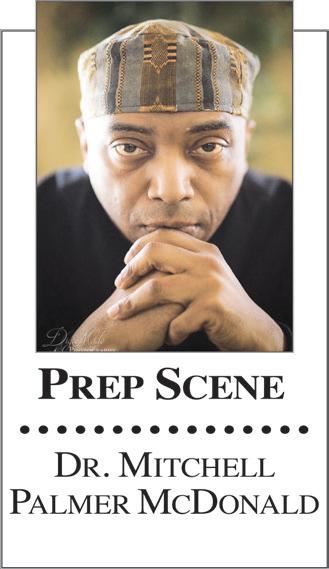
inneapolis North and St. Paul Central were on the winning track last week in high school football.
Senior quarterback Allan Lankfard Jr.’s four touchdowns
led St. Paul Central’s football team to a 36-26 victory over city rival St. Paul Johnson at James S. Griffin Stadium, giving the Minutemen their first victory.
Freshman wide receiver RJ Stuckey and sophomore halfback Colin Moore Jr. scored touchdowns for the Governors.
Across the river, Minneapolis North scored a 56-12 victory over DeLaSalle with senior running back Jajuan Bobmanuel (two touchdowns and three two-point conversions) and junior receiver Jer-

There have been in the past several articles on John Donaldson (1891-1970) and his legendary exploits. Researchers have it that he amassed over 420 wins and over 5,200 strikeouts in over 700 games played.
Given this, why isn’t the Black pitcher’s plaque installed in Cooperstown, New York, where the Baseball Hall of Fame is housed?
We recently asked this of Pete Gorton, a longtime advocate for getting Donaldson
miah Jackson (one touchdown reception) leading the Polars.
Senior wide receiver Richard Apiagyei had a touchdown reception for the Islanders.
Dr. Mitchell Palmer McDonald welcomes reader comments to mcdeezy05@gmail.com.
All photos by Dr. Mitchell Palmer McDonald.

By Charles Hallman Sports Columnist
thletes Unlimited (AU) recently announced that the 2025 AU Pro Basketball Championship season will move to Nashville, Tenn. The 24-game season will run Feb. 5-March 2, 2025.
Last season, 29 of the 40 players had WNBA experience, including Lexie Brown (LA Sparks) and Sydney Colson (Las Vegas).
Megan Perry, AU director of basketball, said in a press release, “Tennessee has long been a hotbed for women’s basketball… We’re excited to bring a roster full of elite
professional
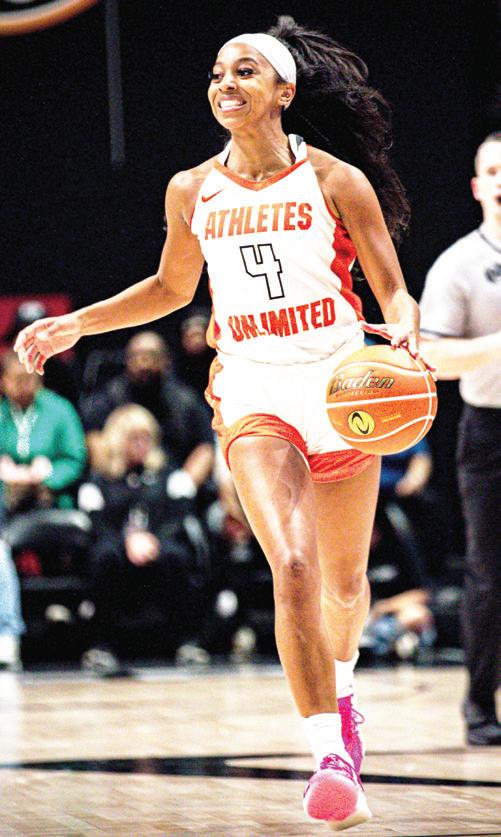

and Dallas
and 2024).
2021, is the first pro
basketball league launched since the WNBA and ABL in the late 1990s. The league allows WNBA players to stay
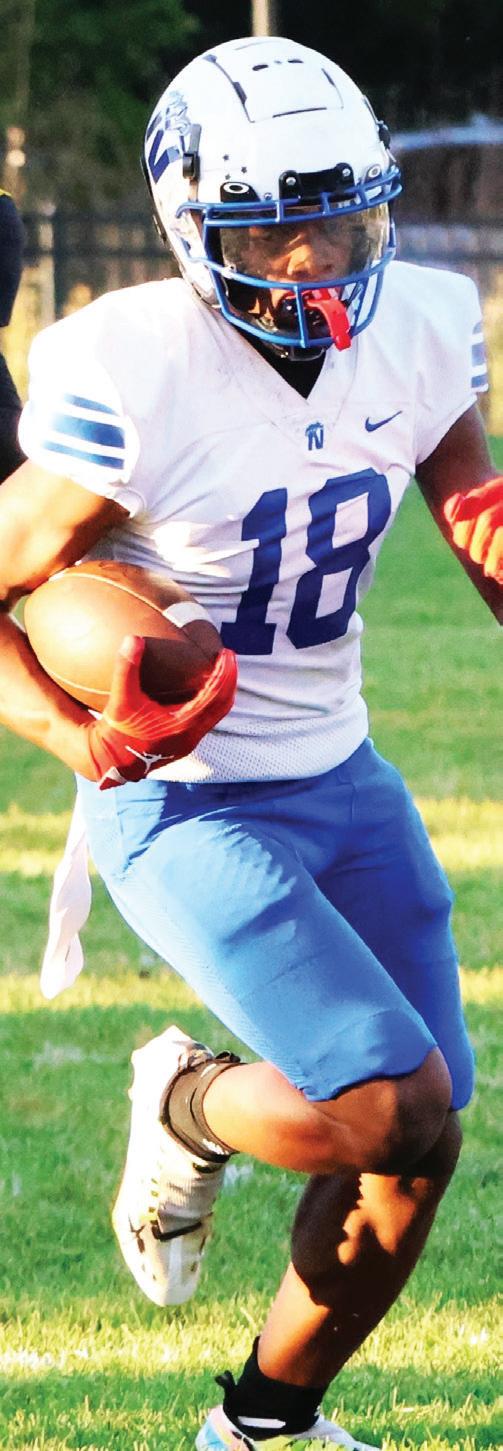


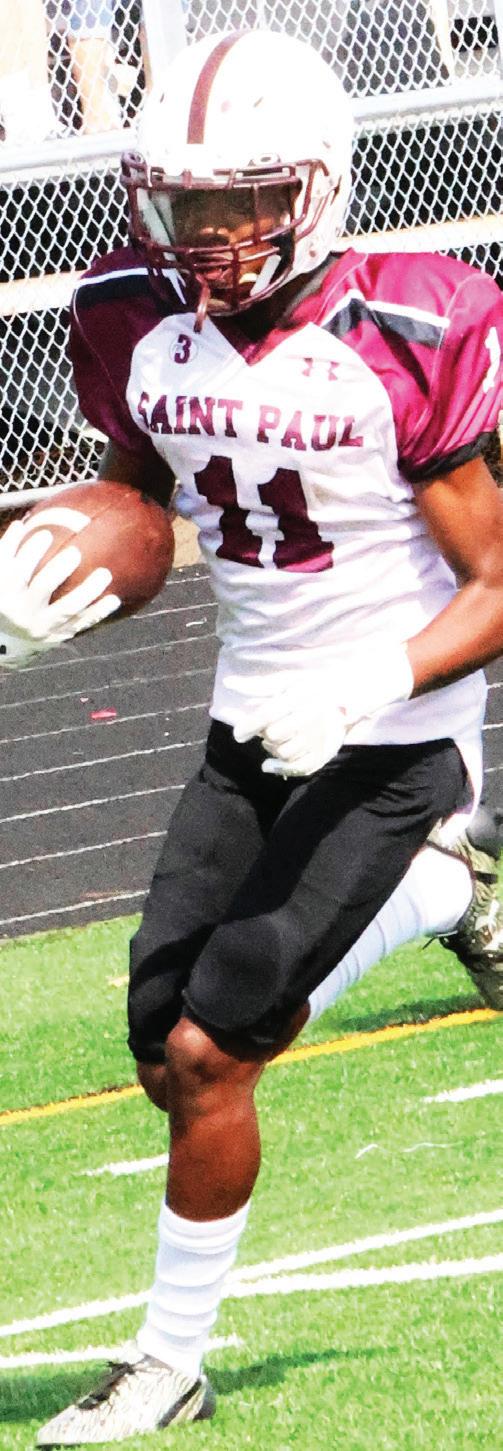
more recognition. He founded the Donaldson Network and talked about the pitcher while sitting on a Black baseball panel at SABR24 in Minneapolis in August.
Donaldson “pitched in 781 cities in North America because of segregation,” reiterated Gorton. “More wins, more strikeouts than any segregated pitcher all time.”
1920-23) and for the Kansas City Monarchs for six years. He’s been called “the greatest pitcher of his era.”
Donaldson also pitched in Minnesota: Bertha (1924-25, 1927), Lissmore, Minnesota Gophers (1925-26), Madison and Mineola (both 1925), Melrose and Arlington (both 1928), and St. Cloud (1930).
Gorton and local histo-
“You’re going to lose dozens of
According to Wikipedia, Donaldson pitched in preNegro League times and for several Negro Leagues clubs in a career that spanned over 30 years. He pitched for such clubs as All Nations (1912-18;
rian Steven Hoffbeck once co-wrote for SABR, “We consider John Donaldson the best left-handed barnstorming pitcher in Black baseball history. He accumulated 5,081 [strikeouts] in his lifetime.” He
reportedly last pitched for an Iowa team in 1949.
The Negro Leagues Database (seamheads.com) also published Donaldson’s Black baseball stats: 23-29 W-L record, 2.96 ERA, 257 strikeouts and 450 innings pitched. Donaldson also played centerfield and compiled a .281 career batting average (seven HRs, 162 RBI) with 34 stolen bases and 168 runs.
However, according to the database disclaimer, Donaldson’s stats are incomplete. This might explain why he has not yet reached the hallowed Hall of Fame, especially with the first batch of pre-integration Black baseball players who were inducted in 2006. Since this spring, MLB now recognizes Negro Leagues statistics
